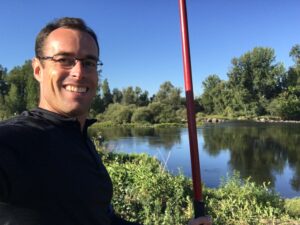In his quality of Associate Editor to BMJ Open SEM, Prof. Pascal Edouard was invited to present his perspective on Sport & Exercise Medicine (SEM) in his home country, France.

Tell us more about yourself.
I am a Medical Doctor, University Professor and Hospital Practitioner in Physiology, focusing on Sports Medicine at the Jean Monnet University and University Hospital of Saint-Etienne in France. Clinically, I have been in charge of our Sports Medicine Unit since 2013. I am also teaching at the Faculty of Medicine Jacques Lisfranc in Saint-Etienne, where I deliver lectures on Exercise Physiology and Sports Medicine. Finally, my research activities, conducted at the Laboratoire Interuniversitaire de Biologie de la Motricité, focus on injury prevention, particularly for hamstring injuries and track and field athletes.

What is the path to becoming a sport and exercise physician in France, and what are the main hurdles on this path?
In France, SEM is not a medical speciality on its own. After six years of medical school, students complete a national examination, which will determine their speciality (e.g., general practice, cardiology, surgery, public health, etc.) and the University Hospital where they will learn it (this training period is named internat). Currently, there are two ways to officially become an SEM physician. The first path consists of an additional year of training devoted to SEM (known as Formation Spécialisée Transversale in SEM), which must be taken during the internat. This year encompasses full-time clinical work in SEM units and theoretical teaching. The second path, known as Capacité de Médecine du Sport, can be entered after the internat. As soon as the physician obtained an MD thesis (conversely to the UK or USA), it is necessary to write a doctoral dissertation to get your MD title). This year consists of theoretical teaching and 30 half-days of practical work by shadowing SEM physicians. Finally, several universities deliver postgraduate diplomas, which enable them to deepen SEM knowledge or competencies. However, the obtention of these diplomas does not allow physicians to call themselves SEM physicians.
How developed is collaborative work in SEM in France?
SEM tends to be collaborative, both multidisciplinary and interdisciplinary. As SEM is not a speciality on its own, French SEM physicians have different medical backgrounds (mainly general practice, physical medicine and rehabilitation, physiology, orthopaedic surgery, and cardiology), which favours interaction between medical specialists. There are also essential collaborations with paramedical personals (e.g., physiotherapy, psychology, dietetic).
Are exercise physiologists/scientists integrated into your healthcare system, and does health insurance cover their services?
Exercise physiologists/scientists are, to my knowledge, not integrated into the French healthcare system. They mainly work in research (exercise physiology, physical activity promotion for health, injury prevention) and professional sports. Some are involved in private clinics, but insurances do not cover their activities unless a medical doctor prescribed, supervised and validated it as part of a treatment plan. Indeed, as far as I know, the Universal French healthcare insurance covers only treatment-related services; prevention is not covered. In my opinion, it is unfortunate not to consider exercise physiologists/scientists as healthcare providers and that insurance does not cover prevention services.
What is done in France to promote SEM among students and young professionals regarding research and clinical opportunities?
Unfortunately, not enough is done. There are only a minimal number of SEM teaching included in medical school curricula. Out of the 367 lectures delivered to prepare for the final national examination, only three are related to SEM. Some medical schools offer optional undergraduate SEM courses, but only about 20% of all students can access them. On average, there are only two positions per year per university to enter the Formation Spécialisée Transversale (path 1), while more than 6 candidates apply per year and university. Consequently, it is easier to enter the Capacité de Médecine du Sport (path 2) or register to postgraduate University Diplomas to gain knowledge in SEM. However, the latter offer less clinical exposure to candidates.
Finally, if you were Harry Potter, what would you change to SEM in France?
I do not know if the grass is greener in other countries. However, we still have a long path to go here (even if several previous generations of SEM physicians did their best to improve the situation). First, changes in the French healthcare system would be necessary to make prevention more meaningful and attractive. It is also required to acknowledge and promote physical activity as a part of medical care. These changes of paradigm would have a positive impact on SEM. Indeed, to implement them, it will be necessary to better train future physicians in SEM-related topics and integrate more SEM teachings in medical school. To realise the latter, it would be required that SEM becomes a medical speciality to have enough qualified teachers, researchers, and practitioners.